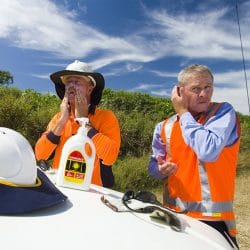IN THIS ISSUE
Spotlight on night shift work – New report on research challenges and publication on workplace estimates
Updating resources – Reducing workplace exposure to antineoplastic agents, new pesticide and ionizing radiation estimates
Communications update – Webinar recordings on workplace exposure to sun and antineoplastic agents now available
Recent publications – New publication on the burden of workplace radon exposure
SPOTLIGHT ON NIGHT SHIFT WORK
New report on research challenges and publication on workplace estimates
The International Agency for Research on Cancer recently released their evaluation on the carcinogenicity of night shift work, classifying it as probably carcinogenic to humans due to limited evidence in humans for cancers of the breast, prostate, colon, and rectum. In response to ongoing uncertainties in research on night shift work, our team has produced a new report, “Carcinogenicity of night shift work: Data gaps and research challenges”. Results show that the main challenges include:
- Adequately assessing exposure to this unique circumstance (i.e. working at night)
- Capturing the population at highest risk of cancer in research studies
- Disentangling the complex and related mechanisms of action that lead to cancer
The report is available here.
Our estimates of workplace exposure to night shift work have been published in the Annals of Work Exposures and Health. Approximately 1.8 million Canadians were exposed to night shift work in 2011. Industries with the largest number of exposed workers were trade (396,000 exposed), healthcare/social assistance (318,000), and manufacturing (261,000 exposed). The publication is available here.
UPDATING RESOURCES
Reducing workplace exposure to antineoplastic agents
Our new resources on reducing workplace exposure to antineoplastic agents are now available. Our team examined the factors that affect safe handling of antineoplastic agents and produced several resources to support exposure reduction efforts, including:
- A compendium of policy levers for safe handling in different healthcare settings
- A comparison of policy levers for safe handling in Alberta, Manitoba, and British Columbia
- A prevention framework to help organizations assess and audit their own safety procedures and plans
The resources are available here.
Workplace and environmental exposure estimates for three pesticides now available
We recently developed occupational and environmental exposure estimates for three pesticides commonly sold in Canada – chorothalonil, 2,4-D, and glyphosate.
Our occupational estimates show the number of workers exposed to each pesticide, as well as breakdowns by farm type and region. In Canadian agricultural workplaces, we estimate that:
- Up to 14,000 workers are exposed to chlorothalonil
- Up to 43,000 workers are exposed to 2,4-D
- Up to 55,000 workers are exposed to glyphosate
Our environmental estimates show the number of people potentially exposed to each pesticide by region based on their residential proximity to agricultural areas, as well as national maps of agricultural pesticide usage. In Canadian communities, we estimate that:
- Over 1.5 million people live in areas with higher potential for chlorothalonil exposure
- Over 2 million people live in areas with higher potential for 2,4-D exposure
- Over 2 million people live in areas with higher potential for glyphosate exposure
Our pesticide estimates and other resources are available here.
New ionizing radiation estimates and summaries for emerging issues
We recently updated our occupational exposure estimates for ionizing radiation and found that approximately 35,000-86,000 Canadians are exposed to ionizing radiation at work. These exposures are most prevalent in nurses, aircrew members, ward aids, and orderlies. The occupational exposure estimates are available here.
We also monitor substances of growing concern to Canadians, and have two new emerging issues summaries available on our website:
- Workplace exposure to ultraviolet radiation from indoor farming lights used to promote plant growth
- Perfluoroalkyl substances (PFAS), a large group of synthetic chemicals used in a variety of consumer and industrial products including adhesives, cleaning products, cosmetics, and fire-fighting foams
The new emerging issues summaries are available here.
COMMUNICATIONS UPDATE
Webinar recordings on workplace exposure to sun and antineoplastic agents now available
Two new webinar recordings are now available online:
- Sun exposure in outdoor workers – Measurement and monitoring discusses the risks of occupational sun exposure, shares results from an ultraviolet radiation exposure monitoring project of outdoor workers in Alberta, and outlines the barriers and facilitators that influence surveillance systems for outdoor workers.
- Reducing occupational exposure to antineoplastic drugs discusses the factors that influence the safe handling of antineoplastic drugs, shares an updated comparison of safe handling policy levers, and provides tools to support safer environments for workers handling antineoplastic drugs.
The webinar recordings are available here.
RECENT PUBLICATIONS
New publication on the burden of workplace radon exposure
Newly published results from the Burden of Occupational Cancer in Canada Study show that 0.8% of lung cancers in Canada are caused by workplace exposure to radon, corresponding to approximately 188 lung cancer cases per year. The majority of indoor workers were exposed to relatively low levels of radon in the workplace. The publication is available here.
Please note that the CAREX Canada e-Bulletin is now a bi-annual digest. For more regular communications from us, please subscribe to Carcinogens in the News, a monthly digest of media articles, government reports, and academic literature related to the carcinogens we’ve classified as important for surveillance in Canada.
Subscribe to our newsletters
The CAREX Canada team offers two regular newsletters: the biannual e-Bulletin summarizing information on upcoming webinars, new publications, and updates to estimates and tools; and the monthly Carcinogens in the News, a digest of media articles, government reports, and academic literature related to the carcinogens we’ve classified as important for surveillance in Canada. Sign up for one or both of these newsletters below.
CAREX Canada
School of Population and Public Health
University of British Columbia
Vancouver Campus
370A - 2206 East Mall
Vancouver, BC V6T 1Z3
CANADA
As a national organization, our work extends across borders into many Indigenous lands throughout Canada. We gratefully acknowledge that our host institution, the University of British Columbia Point Grey campus, is located on the traditional, ancestral and unceded territories of the xʷməθkʷəy̓əm (Musqueam) people.








